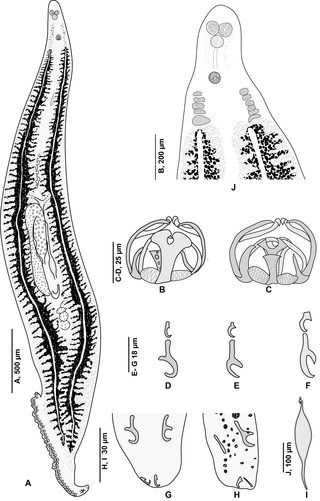
Microcotyle is a genus which belongs to the phylum Platyhelminthes and class Monogenea. Species of Microcotyle are ectoparasites that affect their host by attaching themselves as larvae on the gills of the fish and grow into adult stage. This larval stage is called oncomiracidium, and is characterized as free swimming and ciliated.

Ida May Mellen (1877–1970) was an American ichthyologist and biologist. She worked at the New York Aquarium from 1916 to 1929.

Pseudorhabdosynochus is a genus of monopisthocotylean monogeneans, included in the family Diplectanidae. The type-species of the genus is Pseudorhabdosynochus epinepheli .

The Diplectanidae are a family of monopisthocotylean monogeneans. They are all parasitic on the gills of fish. Diplectanids are small animals, generally around 1 mm in length. As parasites, they can be extremely numerous, up to several thousand on an individual fish.

Lagenivaginopseudobenedenia is a genus of monopisthocotylean monogenean, included in the family Capsalidae. The type-species of the genus is Lagenivaginopseudobenedenia etelisYamaguti, 1966. The genus includes only 2 species, which are both parasitic on the gills of marine fish of the family Lutjanidae.

Capsalidae is a family of monopisthocotylean monogeneans, which includes about 200 species.
Pseudorhabdosynochus amplidiscatus is a diplectanid monogenean parasitic on the gills of groupers. It was described as Diplectanum amplidiscatum by Bravo-Hollis in 1954 and transferred to the genus Pseudorhabdosynochus by Kritsky and Beverley-Burton in 1986.
Allobenedenia is a genus of monopisthocotylean monogeneans, included in the family Capsalidae. All species in this genus are parasitic on external surfaces of marine teleosts.

Ancyrocephalidae is a family of monogenean flatworms. The family is considered as a "temporary name" in WorMS but includes a large number of genera and species.

Microcotyle archosargi is a species of monogenean, parasitic on the gills of a marine fish. It belongs to the family Microcotylidae. It was first described by MacCallum in 1913 based on ten specimens. Hargis (1956) pointed out that the description and figures given by MacCallum were poor in details.
Microcotyle cepolae is a species of monogenean, parasitic on the gills of a marine fish. It belongs to the family Microcotylidae.
Microcotyle gimpo is a species of monogenean, parasitic on the gills of a marine fish. It belongs to the family Microcotylidae.
Microcotyle sebastisci is a species of monogenean, parasitic on the gills of marine fish. It belongs to the family Microcotylidae.
Microcotyle tanago is a species of monogenean, parasitic on the gills of a marine fish. It belongs to the family Microcotylidae.

Pseudaxine is a genus which belongs to the phylum Platyhelminthes and class Monogenea; all its species are parasites of fish.
Cynoscionicola is a genus which belongs to the family Microcotylidae and class Monogenea. Species of Cynoscionicola are ectoparasites that affect their host by attaching themselves as larvae on the gills of the fish and grow into adult stage. This larval stage is called oncomiracidium, and is characterized as free swimming and ciliated. This genus was proposed by Price in 1962, to accommodate Cynoscionicola heteracantha and Cynoscionicola pseudoheteracantha . Members of Cynoscionicola are characterised by a genital atrium with two anterior muscular pockets armed with single row of hooked spines, and two posterior lateral muscular pouches armed with spines.
Metamicrocotyla is a genus which belongs to the family Microcotylidae and class Monogenea. It was created by Yamaguti in 1953 to include Metamicrocotyla bora and Metamicrocotyla filiformis from the gills off the flathead grey mullet Mugil cephalus (Mugilidae). As all Monogenea, species of Metamicrocotyla are ectoparasites that affect their host by attaching themselves as larvae on the gills of the fish and grow into adult stage. This larval stage is called oncomiracidium, and is characterized as free swimming and ciliated. Members of Metamicrocotyla are characterized by a symmetrical haptor, a variable number of postovarian testes and with no cirrus nor vagina. their genital atrium is provided with paired groups of spines or hooks.

Microcotylinae is a subfamily within family Microcotylidae and class Monogenea. This subfamily was created by Taschenberg in 1879.
Bivagina is a genus of monogeneans. As all Monogenea, species in the genus are ectoparasites that affect their host by attaching themselves as larvae on the gills of fish and grow into adult stage. This larval stage is called oncomiracidium, and is characterized as free swimming and ciliated.
Polynemicola is a genus of monegenean. As all Monogenea, species of Polynemicola are ectoparasites that affect their host by attaching themselves as larvae on the gills of the fish and grow into adult stage. This larval stage is called oncomiracidium, and is characterized as free swimming and ciliated.






